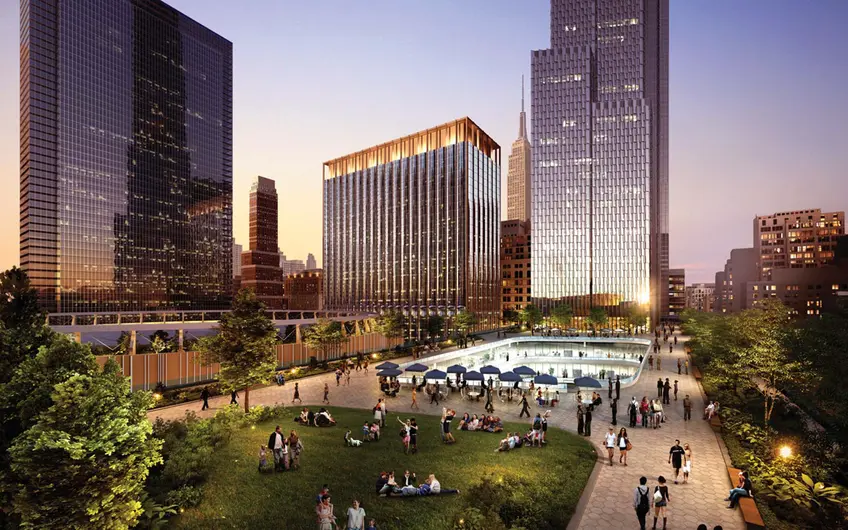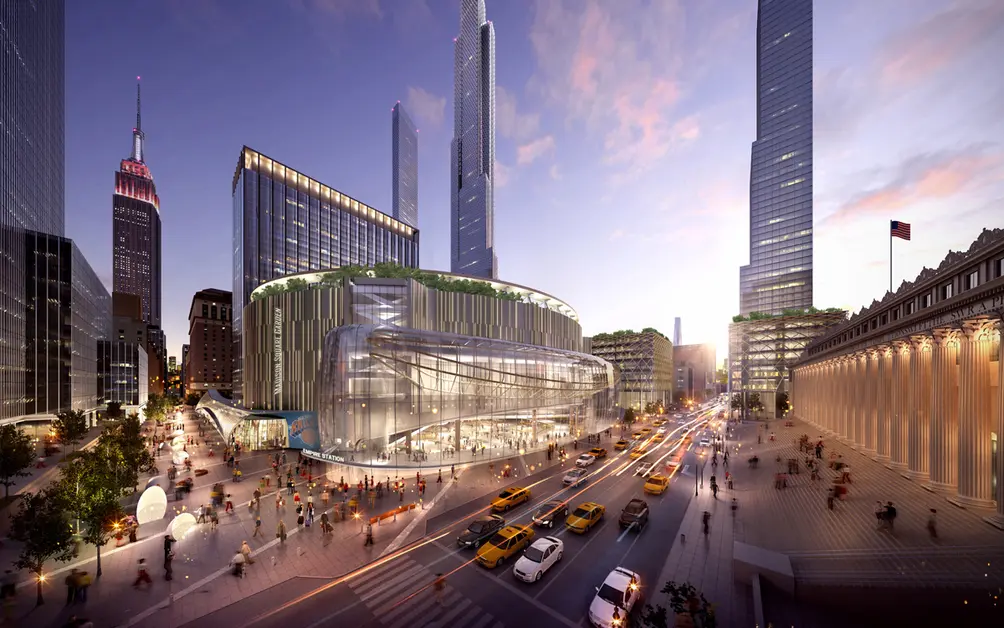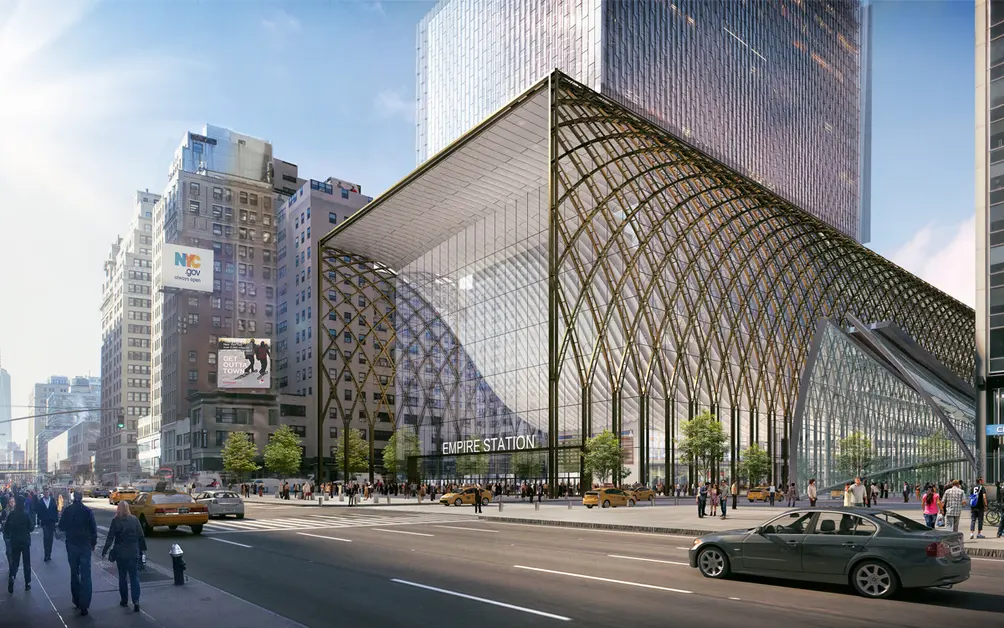 Empire Crossing's green roofscape atop the station's expanded southern block (JDS Development)
Empire Crossing's green roofscape atop the station's expanded southern block (JDS Development)
Earlier this week, Governor Andrew Cuomo enlivened a stalled plan to create a transit-oriented district centered around Penn Station. The dusted-off vision, dubbed the Empire Station Complex, would tie the current station and the soon-to-open Moynihan Train Hall with a new terminal that would span a full city block between 30th and 31st Streets between Seventh and Eighth Avenues. Expanding onto the block would allow for the construction of eight additional tracks which, according to a presentation from the Governor's office, would increase the station’s capacity by 40 percent. Another piece of the plan involves the state acquiring the Theater at Madison Square Garden, allowing for a grand entrance hall to Penn Station to be built along Eighth Avenue.
Observers will notice that this is nearly identical to the plan kicked around 2016, when the state asked teams of developers and architects to come up with their own visions for the new Empire Station Complex. One key difference between this and the old is that the transit district now encompasses two full blocks east of the station between West 34th and 32nd streets. Containing long-envisioned private development opportunities such as Vornado's redevelopment of the Hotel Pennsylvania and 435 Seventh Avenue, the state aims to capture the value of new development through "payments in lieu of taxes" (PILOT) structure.
No completion date has been given, and only time will tell when/if the plan will happen. As we wait and see, we look back at JDS Development's unchosen plan for the transit district called Empire Crossing.
Observers will notice that this is nearly identical to the plan kicked around 2016, when the state asked teams of developers and architects to come up with their own visions for the new Empire Station Complex. One key difference between this and the old is that the transit district now encompasses two full blocks east of the station between West 34th and 32nd streets. Containing long-envisioned private development opportunities such as Vornado's redevelopment of the Hotel Pennsylvania and 435 Seventh Avenue, the state aims to capture the value of new development through "payments in lieu of taxes" (PILOT) structure.
No completion date has been given, and only time will tell when/if the plan will happen. As we wait and see, we look back at JDS Development's unchosen plan for the transit district called Empire Crossing.
Empire Crossing
Developer: JDS Development
Architects: SHoP and FXFowle Architects (now FXCollaborative)
 View from Eighth Avenue and 34th Street of JDS' Empire Crossing proposal
View from Eighth Avenue and 34th Street of JDS' Empire Crossing proposal
In 2016, the Empire State Development Corporation gave a tour of Penn Station to many large landlords and builders to submit proposals to overhaul the station by improving the facility, upgrading the interior spaces and entrances, adding new retail, building a large glass opening on Eighth Avenue and potentially relocating the Madison Square Garden theater. Along with Penn Station, the developers were told they could bid on renovating the Farley Post Office Building – now known as Moynihan Train Hall – into retail, office, and hotel spaces. The new Empire Station Complex would become a state-of-the-art transportation hub.
The project, which will be a massive $3 billion, multi-year major renovation, is intended to enhance amenities, improve passenger facilities, increase train capacity, and decrease passenger congestion. Boston Properties, Brookfield, Related Cos., Silverstein Properties, Tishman Speyer, Vornado Realty Trust, Madison Capital and JDS Development all toured the facility.
The project, which will be a massive $3 billion, multi-year major renovation, is intended to enhance amenities, improve passenger facilities, increase train capacity, and decrease passenger congestion. Boston Properties, Brookfield, Related Cos., Silverstein Properties, Tishman Speyer, Vornado Realty Trust, Madison Capital and JDS Development all toured the facility.
Vornado Realty Trust and Related were chosen for the Farley Building redevelopment, which is now underway, but as for Penn Station, the future is still unclear. However, now that Vornado will likely renovate 2 Penn Plaza (it rises directly above Penn Station and serves as an entrance to Madison Square Garden) rather than raze and rebuild, a 2016 proposal from JDS Development just might be possible.
JDS Development’s proposal, called Empire Crossing, wouldn't touch 2 Penn Plaza but would radically expand Penn Station without interrupting the flow of passengers. Empire Crossing would be a new district "that creates the revenue streams needed to make it a reality" to solve the transit hub's overcapacity issue.
Their report starts with the premise that Penn Station is at a breaking point. The intended design capacity of Penn Station was 40,000 people per hour (peak) but as of 2015, Penn Station was 62.5% over design capacity, operating at 65,000 people per hour. And by 2032, it is predicted that it will be 375% over the capacity.
Their report starts with the premise that Penn Station is at a breaking point. The intended design capacity of Penn Station was 40,000 people per hour (peak) but as of 2015, Penn Station was 62.5% over design capacity, operating at 65,000 people per hour. And by 2032, it is predicted that it will be 375% over the capacity.
JDS Development compares their proposal to build a new Empire station, which is an “engineered solution” that solves the “critical capacity” issue, to 1816, when "future Governor DeWitt Clinton submitted a petition to create the Erie Canal. Critics as powerful as Thomas Jefferson called it foolish—a dream too big and a century ahead of its time. Acquiring the land would be challenging, construction would be complicated, and financing the project would require unprecedented coordination of both public and private investment. When completed nine years later, it would be called the eighth wonder of the world. Within a decade, the entire cost of construction had been recouped. The Erie Canal did more than just stimulate commerce. It unleashed the power and prominence of New York State through unfettered connectivity. It changed the game. We have the chance to change the game again.”
There are six key features of their Empire station proposal:
1) Radically expand intermodal connectivity to increase capacity and safety, including, for the first time, dedicated airport and regional high-speed rail service
2) Create a light- and air-filled, energy-efficient station in 60 months by renovating Penn Station and eliminating the current B level.
3) Exercise eminent domain to expand Empire Station with additional tracks to meet forecasted transit demand.
4) Add world-class retail and public green spaces to create the world’s next and best transit station experience.
5) Create a vibrant district and destination with millions of square feet of commercial, civic and infrastructure development opportunities.
6) A fast-track proposed schedule for a 2032 completion in time to fully realize Hudson Gateway Tunnel potential and meet projected demand.
1) Radically expand intermodal connectivity to increase capacity and safety, including, for the first time, dedicated airport and regional high-speed rail service
2) Create a light- and air-filled, energy-efficient station in 60 months by renovating Penn Station and eliminating the current B level.
3) Exercise eminent domain to expand Empire Station with additional tracks to meet forecasted transit demand.
4) Add world-class retail and public green spaces to create the world’s next and best transit station experience.
5) Create a vibrant district and destination with millions of square feet of commercial, civic and infrastructure development opportunities.
6) A fast-track proposed schedule for a 2032 completion in time to fully realize Hudson Gateway Tunnel potential and meet projected demand.
To do this, SHoP Architects and FXCollaborative have designed an attractive, curved glass, airy station entrance that would capture the natural light from the street and diffuse it through the underground station.
 New 7th Avenue grand entrance to Empire Station at 31st Street
New 7th Avenue grand entrance to Empire Station at 31st Street
The segment detailing JDS Development's Empire Crossing was originally published in June 2018 by Michelle Sinclair Colman

 6sqft delivers the latest on real estate, architecture, and design, straight from New York City.
6sqft delivers the latest on real estate, architecture, and design, straight from New York City.
